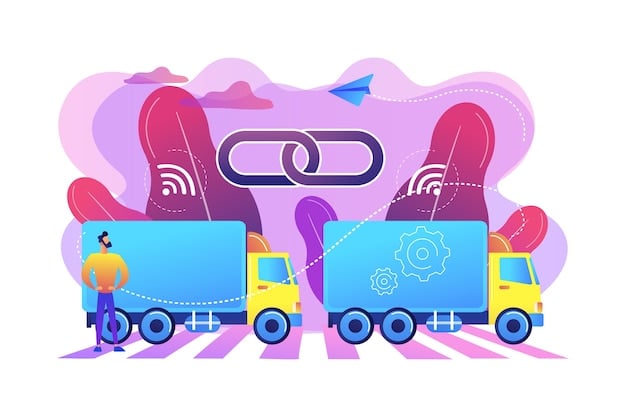Supply Chain Disruptions: Adapting and Mitigating Risks in 2025

Supply Chain Disruptions in 2025 demand proactive adaptation; businesses are leveraging technology, diversifying sourcing, and enhancing resilience through predictive analytics and risk mitigation strategies to navigate an increasingly uncertain global landscape.
The modern business landscape is increasingly defined by volatility, with supply chain disruptions posing a significant threat. As we move towards 2025, understanding how businesses are adapting and mitigating these risks becomes crucial for survival and success.
Understanding the Evolving Landscape of Supply Chain Disruptions
Supply chain disruptions are no longer isolated incidents; they are a persistent reality. A simple breakdown in any part of the global network can lead to delays, increased costs, and lost revenue.
Several factors contribute to this evolving landscape, including geopolitical instability, climate change, and rapid technological advancements.
Geopolitical Instability
Trade wars, political unrest, and international sanctions can all disrupt supply chains. These events can lead to sudden changes in tariffs, border closures, and restrictions on the movement of goods.
Climate Change
Extreme weather events, such as hurricanes, floods, and droughts, are becoming more frequent and severe. These events can damage infrastructure, disrupt transportation routes, and impact agricultural production, all of which can have cascading effects on supply chains.
Technological Advancements
While technology can improve efficiency in supply chains, it also introduces new vulnerabilities. Cyberattacks, data breaches, and system failures can disrupt operations and compromise sensitive information.
- The Shift from Just-in-Time to Just-in-Case: Companies are moving away from lean manufacturing principles to build buffer stock to protect against disruptions.
- Increased Demand for Transparency: Consumers and businesses alike are demanding greater visibility into the origins and journey of products.
- The Rise of Reshoring and Nearshoring: Companies are reconsidering their global footprint and bringing production closer to home to reduce reliance on distant suppliers.
In conclusion, the evolving landscape of supply chain disruptions requires businesses to be proactive and adaptable. By understanding the key drivers of these disruptions, companies can take steps to mitigate risks and build more resilient supply chains.

Adapting Sourcing Strategies for Resilience
One of the most effective ways to mitigate supply chain risks is to diversify sourcing strategies. Relying on a single supplier or a limited number of suppliers can leave businesses vulnerable to disruptions.
By expanding their supplier base, companies can reduce their dependence on any one source and increase their ability to withstand disruptions.
Diversification of Suppliers
Rather than relying on a single supplier, companies can spread their orders across multiple suppliers, ideally located in different geographic regions. This reduces the impact of disruptions affecting a specific supplier or region.
Dual Sourcing
Dual sourcing involves using two suppliers for the same product or component. This provides a backup option in case one supplier experiences a disruption. It also encourages competition and can lead to better pricing and quality.
Nearshoring and Reshoring
Nearshoring involves moving production closer to home, typically to neighboring countries. Reshoring, on the other hand, involves bringing production back to the company’s home country.
- Reduced Lead Times: Nearshoring and reshoring can significantly reduce lead times, making the supply chain more responsive to changes in demand.
- Improved Communication: Closer proximity can facilitate better communication and collaboration with suppliers.
- Reduced Transportation Costs: Bringing production closer to home can lower transportation costs and reduce the environmental impact of shipping goods over long distances.
In conclusion, adapting sourcing strategies is essential for building resilient supply chains. By diversifying suppliers, implementing dual sourcing, and exploring nearshoring and reshoring options, businesses can reduce their vulnerability to disruptions and enhance their competitiveness.
Leveraging Technology for Enhanced Visibility and Prediction
Technology plays a critical role in enhancing supply chain visibility and improving prediction capabilities. Advanced technologies can provide real-time insights into the flow of goods, identify potential disruptions, and enable businesses to respond quickly and effectively.
Adopting these technologies can help businesses to make better decisions, optimize their operations, and mitigate risks.
Real-Time Monitoring and Tracking
IoT (Internet of Things) sensors and GPS tracking devices can provide real-time visibility into the location and condition of goods as they move through the supply chain. This enables businesses to identify potential delays, monitor temperature-sensitive products, and prevent theft or damage.
Predictive Analytics
Predictive analytics uses historical data and statistical algorithms to forecast future events. In the context of supply chains, this can involve predicting demand, identifying potential disruptions, and optimizing inventory levels.
AI and machine learning algorithms can analyze vast amounts of data to identify patterns and predict potential disruptions. This enables businesses to take proactive measures to mitigate risks, such as adjusting production schedules or securing alternative sources of supply.
- Improved Decision-Making: Real-time data and predictive analytics enable businesses to make better informed decisions about inventory management, production planning, and transportation routing.
- Reduced Costs: By optimizing operations and mitigating risks, technology can help businesses reduce costs and improve profitability.
- Enhanced Customer Service: Improved visibility and responsiveness can lead to better customer service and increased customer satisfaction.

In conclusion, leveraging technology is crucial for enhancing supply chain visibility and improving prediction capabilities. By adopting advanced technologies such as IoT, blockchain, and AI, businesses can build more resilient and responsive supply chains.
Building Inventory Resilience: Safety Stock and Strategic Stockpiling
Maintaining optimal inventory levels is essential for meeting customer demand while minimizing the risk of stockouts. Building inventory resilience involves strategic use of safety stock and stockpiling.
This can help businesses to buffer against unexpected disruptions and ensure that they can continue to meet customer needs even in challenging circumstances.
Safety Stock Strategies
Safety stock is extra inventory held to buffer against unexpected fluctuations in demand or supply. Determining the appropriate level of safety stock requires careful analysis of historical data, lead times, and demand variability.
Strategic Stockpiling
In certain cases, businesses may choose to stockpile critical components or materials to protect against potential disruptions. This involves accumulating larger-than-normal inventory levels of key items.
Balancing cost considerations with the need for resilience is crucial when implementing stockpiling strategies. Businesses must weigh the potential benefits of having extra inventory against the costs of storage, insurance, and obsolescence.
- Improved Customer Service: Maintaining adequate inventory levels can help businesses meet customer demand and avoid stockouts.
- Reduced Revenue Loss: By preventing stockouts, businesses can avoid losing sales and maintain revenue streams.
- Enhanced Flexibility: Having extra inventory on hand can provide businesses with greater flexibility to respond to unexpected changes in demand or supply.
In conclusion, building inventory resilience is an important aspect of mitigating supply chain risks. By strategically using safety stock and stockpiling, businesses can buffer against disruptions and ensure that they can continue to meet customer needs even in challenging circumstances.
Collaborative Partnerships and Information Sharing
Effective collaboration with suppliers, customers, and other stakeholders is essential for building resilient supply chains. By sharing information and working together, businesses can improve visibility, coordinate responses to disruptions, and build stronger relationships.
This involves establishing clear communication channels, sharing data on demand and inventory levels, and working together to identify and mitigate risks.
Supplier Relationship Management
Building strong relationships with key suppliers is crucial for ensuring a stable and reliable supply of goods. This involves regular communication, sharing information on demand forecasts, and working together to improve efficiency and reduce costs.
Customer Collaboration
Collaborating with customers can also improve supply chain resilience. This can involve sharing information on demand patterns, working together to optimize order quantities, and coordinating promotional activities.
Information Sharing Platforms
Advanced technology platforms can facilitate information sharing and collaboration among supply chain partners. These platforms can provide real-time visibility into inventory levels, demand forecasts, and potential disruptions.
In conclusion, collaborative partnerships and information sharing are essential for building resilient supply chains. By working together and sharing information, businesses can improve visibility, coordinate responses to disruptions, and build stronger relationships.
Risk Mitigation Strategies: Insurance, Diversification, and Contingency Planning
Implementing robust risk mitigation strategies is critical for protecting supply chains from disruptions. This involves identifying potential risks, assessing their impact, and developing plans to minimize their effects.
These strategies can help businesses to minimize the impact of disruptions and maintain business continuity.
Insurance Coverage
Obtaining adequate insurance coverage is an important risk mitigation strategy. This can protect businesses from financial losses resulting from disruptions, such as damage to goods, business interruption, or liability claims.
Diversification of Transportation Routes
Relying on a single transportation route can leave businesses vulnerable to disruptions, such as port congestion, road closures, or natural disasters. Diversifying transportation routes can provide alternative options in case of disruptions.
Contingency Planning
Developing detailed contingency plans is essential for responding effectively to disruptions. These plans should outline specific steps to be taken in the event of a disruption, such as activating backup suppliers, rerouting shipments, or adjusting production schedules.
Regularly testing and updating contingency plans is crucial for ensuring their effectiveness. This involves conducting simulations, reviewing lessons learned from past disruptions, and making necessary adjustments to the plans.
- Reduced Financial Losses: Effective risk mitigation strategies can help businesses minimize financial losses resulting from disruptions.
- Improved Business Continuity: By preparing for disruptions and developing contingency plans, businesses can maintain business continuity and minimize the impact on operations.
- Enhanced Reputation: Responding effectively to disruptions can enhance a company’s reputation and strengthen its relationships with customers and suppliers.
In conclusion, implementing robust risk mitigation strategies is critical for protecting supply chains from disruptions. By obtaining adequate insurance coverage, diversifying transportation routes, and developing detailed contingency plans, businesses can minimize the impact of disruptions and maintain business continuity.
| Key Point | Brief Description |
|---|---|
| 🌐 Diversify Sourcing | Expand supplier base across different regions to reduce dependency. |
| 🤖 Leverage Technology | Use IoT, AI, and blockchain for real-time visibility and prediction. |
| 🛡️ Risk Mitigation | Implement insurance, diversify routes, and develop contingency plans. |
| 🤝 Collaboration | Enhance partnerships and information sharing among stakeholders. |
FAQ
▼
Geopolitical instability, climate change, cyberattacks, and unforeseen global events like pandemics continue to be primary drivers of supply chain disruptions, necessitating resilient strategies.
▼
Diversification involves expanding the supplier base across multiple geographic regions, implementing dual sourcing, and considering nearshoring or reshoring to reduce dependency on single sources.
▼
IoT sensors, GPS tracking, AI, machine learning, and blockchain provide real-time monitoring, predictive analytics, and improved transparency across the entire supply chain network.
▼
Safety stock acts as a buffer against unexpected demand fluctuations and supply shortages, ensuring businesses can meet customer needs even when facing disruptions.
▼
Establish clear communication channels, share demand forecasts, work together to improve efficiency, and utilize information-sharing platforms to foster stronger supplier relationships.
Conclusion
In conclusion, navigating supply chain disruptions in 2025 requires a holistic approach encompassing diversified sourcing, technological integration, strategic inventory management, collaborative partnerships, and robust risk mitigation. By embracing these strategies, businesses can build resilient supply chains capable of weathering any storm.





